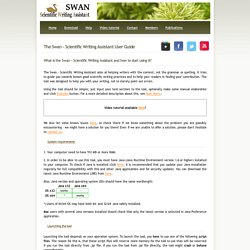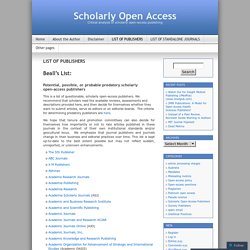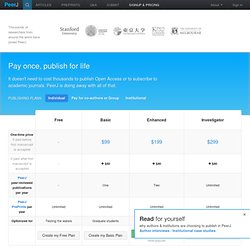

Utopia Docs. When The Scientist Presents. Besides the podcasts on iTunes, the Videos on SCIVEE, and the “learning from famous presenters” series, this blog contains general tips quite useful for scientific presentations.

They are listed here in point form. On the role and merit of a subtitle in a presentation On the best book to buy to learn about scientific presentations On addressing you when your name is difficult to pronounce On pre-empting difficult questions prior to the Q&A On selecting the best candidate to take questions from during the Q&A On checking that each slide ties in with the title of your presentation On attention spans and rules of thumb On keeping up to date with the latest developments in presentation skills On managing time by creating invisible time-saving shortcuts (hyperlinks) On the good use of animations in a presentation On the need to be in good terms with your audience.
Resources for the presenter scientist. Swan - Scientific Writing Assistant. Swan - Scientific Writing Assistant. What is the Swan - Scientific Writing Assistant and how to start using it?

The Swan - Scientific Writing Assistant aims at helping writers with the content, not the grammar or spelling. It tries to guide you towards known good scientific writing practices and to help your readers in finding your contribution. The tool was designed to help you with your writing, not to merely point out errors. Using the tool should be simple; just input your text sections to the tool, optionally make some manual elaboration and click Evaluate button. For a more detailed description about this, see Main Menu. Video tutorial available here! We also list some known issues here, so check there if we know something about the problem you are possibly encountering - we might have a solution for you there! System requirements.
Scholarlyoa.files.wordpress.com/2012/11/criteria-2012-2.pdf. Criteria for Determining Predatory Open-Access Publishers (2nd edition) In August 2012, I published the first edition of my Criteria for Determining Predatory Open-Access Publishers.

I received many helpful comments and am now publishing a second edition of the work. I am especially grateful to Bill Cohen and Dr. Michael W. Firmin for their helpful suggestions. Also, thanks to all the those who left helpful comments or who sent in emails with suggestions. Criteria for Determining Predatory Open-Access Publishers By Jeffrey Beall 2nd edition / December 1, 2012 1. A. LIST OF PUBLISHERS. Beall’s List: Potential, possible, or probable predatory scholarly open-access publishers This is a list of questionable, scholarly open-access publishers.

We recommend that scholars read the available reviews, assessments and descriptions provided here, and then decide for themselves whether they want to submit articles, serve as editors or on editorial boards. The criteria for determining predatory publishers are here. We hope that tenure and promotion committees can also decide for themselves how importantly or not to rate articles published in these journals in the context of their own institutional standards and/or geocultural locus. Last updated December 28, 2015 Appeals: If you are a publisher and would like to appeal your firm’s inclusion on this list, please go here.
Like this: Like Loading... Pricing - Individual Memberships. Authors who choose to pay for a publishing plan at submission get the cheapest rates, however authors can choose to submit for 'free' and pay only once accepted - in that instance their publication rates are slightly higher.

Our base model is for you to get a publishing plan on or before submission. However, when you pay at the point of submission, then there is the risk that having taken your money, we still unfortunately reject your manuscript. Therefore, you might not want to take this risk. In addition, because this is a new business model, people are not necessarily used to paying on submission.
We want everyone to be comfortable with their PeerJ experience, therefore we also allow people to submit for free. If you pay for a publishing plan at time of submission then you get the cheapest rates available (for example, $99 for the Basic plan), but if you choose to submit for free and pay only upon acceptance then you will pay an additional premium of $40. PLOS ONE : accelerating the publication of peer-reviewed science. If you have been invited to review a manuscript, please use our online peer review system.

This 2 minute video explains how to accept or decline an invitation to review a manuscript. Brief Overview for PLOS ONE Reviewers If you have been invited to review a submission to PLOS ONE then please consult this 2 minute video which explains how to accept or decline the invitation. Then please carefully study our seven Editorial Criteria for Publication as the criteria employed by PLOS ONE are quite different to other journals you may have reviewed for. 1. Scientific progress requires the exchange and discussion of data and ideas. The peer review of each article is rigorous and concentrates on objective and technical concerns to determine whether the research has been sufficiently well conceived, well executed, and well described to justify inclusion in the scientific record. We also have a fee waiver policy for authors who do not have funds to cover publication fees. 2. 1. 2.